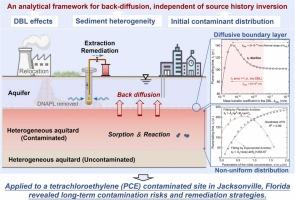扩散边界层和初始污染在非均质低渗透沉积物反向扩散中的作用:一个与来源历史反演无关的模型和现场应用
IF 11.3
1区 环境科学与生态学
Q1 ENGINEERING, ENVIRONMENTAL
引用次数: 0
摘要
由于低渗透沉积物(含水层)的反向扩散造成的持续地下水污染对修复工作提出了挑战,但现有模型往往过于简化关键控制,如扩散边界层(DBL)和初始污染,同时依赖于不确定的源枯竭历史。本研究引入了一种新的分析框架,消除了对源历史的依赖来预测反向扩散动力学,明确地结合了DBL效应、沉积物异质性和空间可变的初始污染物分布。通过控制流室实验和数值模拟对模型进行了验证。应用于佛罗里达州Jacksonville的一个四氯乙烯(PCE)污染场地,该工作成功地利用现场衍生的浓度曲线预测了正向和反向扩散行为,展示了在各种修复方案下羽流持续存在的风险。结果表明,忽略DBL可低估长达40年的尾矿时间,当DBL传质系数(kDBL)较小(即DBL较厚或污染物扩散性较强)时,建议将其纳入反向扩散模型以确保准确预测。极低的kDBL对应于较短的尾烟时间,这意味着抑制DBL间的传质是降低低渗透沉积物反扩散风险的有效策略。此外,初始浓度分布方差(σ)和峰位(μ)显著影响尾流的反向扩散,尾流时间分别呈指数和抛物线型变化,而滞后和扩散率的水体非均匀性与均匀假设相比,会使羽流持续时间增加几个数量级。这种与源历史反演无关的反向扩散模型与DBL相结合,提高了预测的准确性和效率,为管理长期含水层污染风险提供了关键见解。本文章由计算机程序翻译,如有差异,请以英文原文为准。

Roles of diffusive boundary layer and initial contamination in back diffusion from heterogeneous low permeability sediments: A source-history-inversion-independent model and field application
Persistent groundwater contamination due to back diffusion from low-permeability sediments (aquifers) poses a challenge to remediation efforts, yet existing models tend to oversimplify key controls, such as the diffusive boundary layer (DBL) and initial contamination, while relying on uncertain source depletion histories. This study introduces a novel analytical framework that eliminates the dependence on source history to predict back diffusion dynamics, explicitly incorporating the DBL effects, sediment heterogeneity, and spatially variable initial contaminant distribution. The model was validated against controlled flow chamber experiments and numerical simulations. Applied to a tetrachloroethylene (PCE)-contaminated site in Jacksonville, Florida, this work successfully predicts forward and back diffusion behaviors using field-derived concentration profiles, demonstrating plume persistence risks under various remediation scenarios. Results reveal that neglecting DBL underestimates the tailing time by up to 40 years, and when the DBL mass transfer coefficient (kDBL) is small (i.e., when the DBL is thick or the contaminant diffusivity is strong), its inclusion in back-diffusion models is recommended to ensure accurate predictions. Exceptionally low kDBL corresponds to shorter plume tailing time, implying that suppressing mass transfer across DBL is a promising strategy to mitigate back-diffusion risks in low-permeability sediments. Furthermore, Initial concentration distribution variance (σ) and peak position (μ) significantly affect back diffusion, with tailing times varying exponentially and parabolically, respectively, while aquitard heterogeneity in retardation and diffusivity would amplify plume persistence by orders of magnitude compared to homogeneous assumptions. This source-history-inversion-independent back diffusion model, combined with the DBL, enhances predictive accuracy and efficiency, offering critical insights into managing long-term aquifer contamination risks.
求助全文
通过发布文献求助,成功后即可免费获取论文全文。
去求助
来源期刊

Journal of Hazardous Materials
工程技术-工程:环境
CiteScore
25.40
自引率
5.90%
发文量
3059
审稿时长
58 days
期刊介绍:
The Journal of Hazardous Materials serves as a global platform for promoting cutting-edge research in the field of Environmental Science and Engineering. Our publication features a wide range of articles, including full-length research papers, review articles, and perspectives, with the aim of enhancing our understanding of the dangers and risks associated with various materials concerning public health and the environment. It is important to note that the term "environmental contaminants" refers specifically to substances that pose hazardous effects through contamination, while excluding those that do not have such impacts on the environment or human health. Moreover, we emphasize the distinction between wastes and hazardous materials in order to provide further clarity on the scope of the journal. We have a keen interest in exploring specific compounds and microbial agents that have adverse effects on the environment.
 求助内容:
求助内容: 应助结果提醒方式:
应助结果提醒方式:


